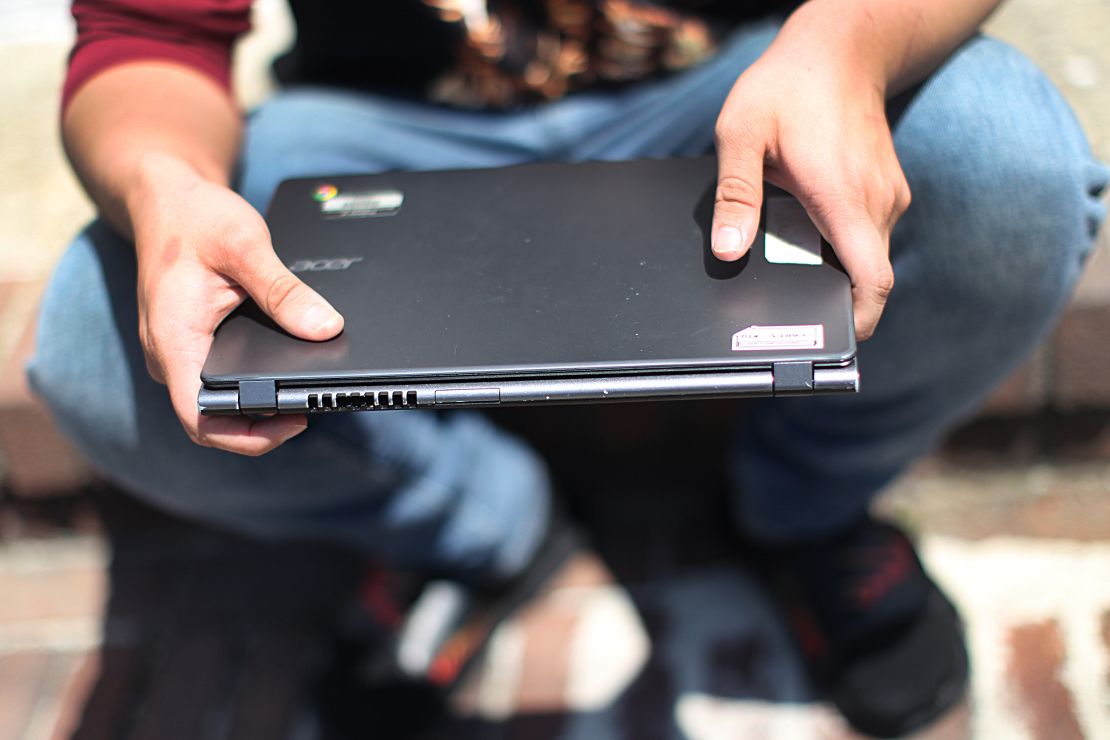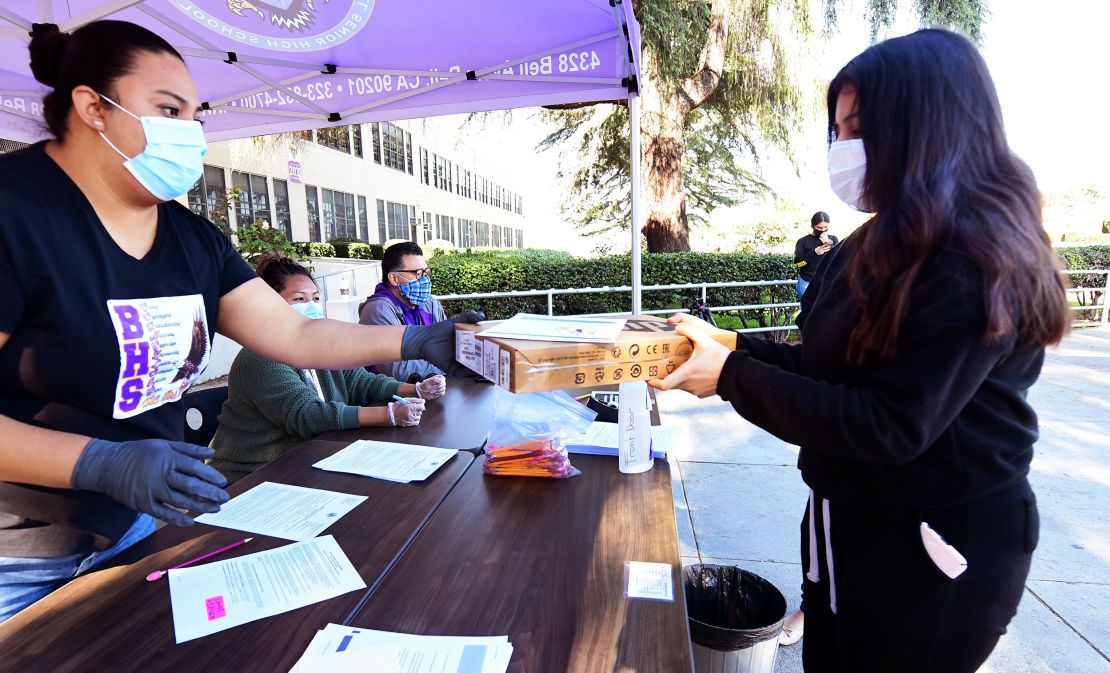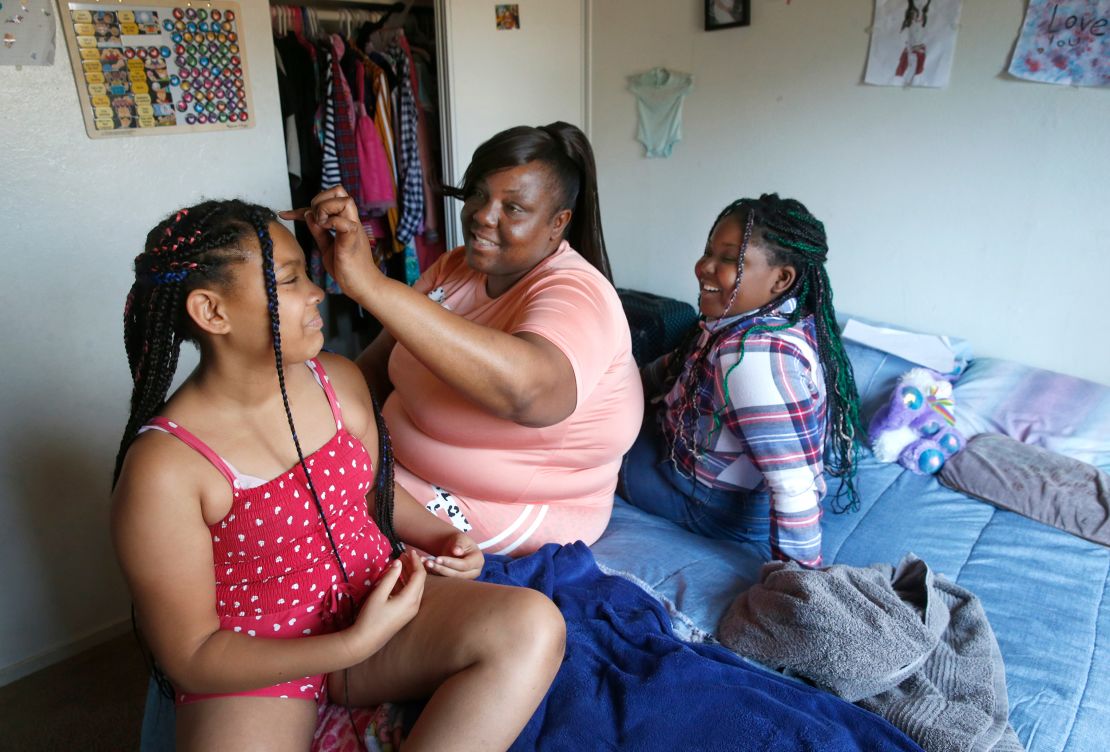Michelle Burnett just landed a new job, and she’s excited to be heading back to work next week for the first time in months. But there’s another upcoming date that’s filling her with dread: the first day of school.
Like parents across the country, the 43-year-old single mom in Vallejo, California, spent many days this past spring struggling to help her children navigate online classes. She watched her daughters falling behind, but often wasn’t sure how to help.
And to make the situation even tougher, she was unemployed. Burnett says she lost her job in April after asking for time off to pick up a school-issued laptop for her youngest daughter.
Now she’s worried her new job could be in jeopardy, too, since the schools her daughters attend will begin the year teaching online once again.
“With them doing distance learning, I have no way of knowing if I can keep a job, and what kind of hours I can work,” Burnett says. And even more distressing, she says, is the ground she sees her children losing academically.
“I don’t feel like my children learned anything (last spring),” she says, and she fears the new school year, which starts August 17, will bring more of the same.
Some of the nation’s more than 56 million K-12 students are thriving in the new remote learning environment. But the shift toward distance learning during the pandemic has exposed long-simmering inequities throughout the US education system, highlighting digital divides along socioeconomic, regional and racial lines.
Millions of school-age children live in households without home internet service, high-speed internet, access to computer devices or help from parents who know how to use them, an expert at Duke University told reporters this week.
“About 8.6 million children, K-12 age, do not have the necessary equipment at home to participate in online learning,” says Kenneth Dodge, a professor who studies early childhood development. “That’s about 1 in 6 children in America.”
'United Shades of America'
And parents like Burnett who spoke with CNN say they’re worried for their children’s futures as the school year approaches. Some say they’re desperate to help their kids, but unsure of where to turn.
“When you make a choice for the world, it needs to fit the world, not just certain groups of people in it,” Burnett says. “I feel like decisions that are being made by the government right now, they don’t impact some people as much as they impact others.”
This essential worker tried to watch her son on a webcam
She couldn’t stop going to her job in the strawberry fields, even though her teenage son was home from school and taking classes online. So Carmen, a single mom in Oxnard, California, who asked to be identified only by her first name, set up a camera to keep an eye on him via her phone while she worked.
Seeing her 14-year-old son sitting at a table with his tablet gave the farmworker peace of mind – until she started hearing from his school.
“Suddenly I started getting messages from his teachers that he hadn’t completed his work,” she says. “Even though I was monitoring him, I saw him there on his tablet, he wasn’t really working. He left a lot of work undone.”
Carmen says she’s frustrated and doesn’t know what to do once the school year starts up again. She’s seen firsthand how easy it is for kids who don’t have a parent at home with them during the school day to disconnect or fall behind.
“It’s a problem that certainly disproportionately affects low-income families who cannot provide that extra support,” Dodge says. “But not only low-income families. Ten million school-age children in America have parents who are health care workers or first responders, police, fire, etc., and they’re not at home.
“There’s a false assumption that everybody, all adults, are at home with nothing to do and can supervise their children.”
Her daughter’s laptop kept breaking
Raquel Lopez Romero says it happened again and again. The school-issued laptop her 9-year-old daughter needed for her classes broke several times over the spring. And each time, Lopez says, it would take days to fix it since there were others waiting to get their laptops repaired, too.
“You’d have to sign up for an appointment and wait,” she says.
Because of that, Lopez says her daughter and countless other students missed days of learning.
The mom in Calexico, California, wishes their family could afford to buy a more reliable computer. But she says while her husband is still working, she’s had to leave her farmworker job to take care of their kids during the pandemic, and their family is struggling to make ends meet with far less income.
“We have to pay rent, electricity, water. … We can’t buy a computer,” she says. “You either eat, or you buy things like that.”

It’s an issue that haunts Lorena Tule-Romain.
“When I think about our students, I think about how we’re going to see them in the future, what they’re able to achieve, where they are academically, because of the lack of resources they had in this particular moment. … That’s what I think scares me the most,” she says, “knowing that there are bigger disparities of access.”
Tule-Romain is a co-founder of ImmSchools, a Texas and New York-based nonprofit that supports undocumented students. The pandemic, she says, has added to growing list of stresses immigrant families face.
“We’re going to be feeling the consequences of this long-term,” she says.
Data on what’s happened so far is still emerging. Researchers from McKinsey last month pointed to models predicting the “learning loss” resulting from the shift to online instruction will be most acute among low-income, Black and Hispanic students.
But things could play out differently in the new school year, thanks to additional planning time, says Jennifer Darling-Aduana, an assistant professor of learning technologies at Georgia State University.
“I’m sure there will still be kinks, and there will be last-minute changes if infection rates change or increase over time,” she says. “But I know how much educators and administrators are working right now to try to make this fall run more smoothly.”
He’s seen what happens when students struggle to get internet at home
David Lopez, a school administrator in Houston, says making sure students had access to computers and high-speed internet was a challenge when classes shifted online last year.
Teachers and students quickly realized the lower-cost internet plans many turned to weren’t fast enough to handle online classes.
“It was really hard to have video conferencing with a teacher to try to get support when your internet is too slow for it,” he says.
Lopez says one family he works with was forced to make the decision to cut off their internet over the summer because they couldn’t afford it.
That meant their son couldn’t attend summer school.
“It was not a priority bill for them, because the money was already short and they needed to pay rent,” he says. “Parents are having to make decisions to cut access to kids’ education because they have to pay rent and find food.”

Last spring, some schools warned they were seeing a growing number of students missing online classes.
It’s a trend that could repeat in the fall.
“Almost one-in-three low-income students in America will not be able to participate adequately in remote education unless we do something, because they don’t have access. That’s compared to only about 7.5 percent of middle-income students,” Dodge says. “So about four times as many low income students are going to be shut out of remote education.”
That could lead to a growing achievement gap with long-lasting consequences, Dodge says.
“A year in the life of a 9-year-old child is a huge proportion of that child’s life,” he says, “and that child will permanently lag behind unless we attend to these problems.”
She fears her special needs student is ‘getting left in the dust’
Burnett says she’s especially concerned about what’s next for her 13-year-old daughter, who has autism and ADHD.
“I just feel like she’s going to get left in the dust,” Burnett says.
Burnett finally felt like they’d gotten to a good place in school after her daughter’s diagnosis in 2019. But she fears the last few months have undone the progress they’d made.
“Right now she’s in the same situation as all the other kids, but worse, because she doesn’t have the same mind state as all the other kids,” Burnett says. “Along with being swept under the rug, just like them, she’s being extra swept under there, because she doesn’t even know what’s going on.”
Many students who require extra assistance in a traditional classroom, such as English-language learners or students in special education programs, didn’t get that as the pandemic forced a rapid shift to virtual learning, says Darling-Aduana of Georgia State University.
“That’s going to be an ongoing struggle,” she says. “There are opportunities and there are ways technology can actually be used to provide a more individualized or personalized type of learning…but in the short term the education of a lot of students who have specific needs and those with different individualized education plans may not have had the highest quality education provided.”

Darling-Aduana, who’s worked with schools to help them develop better online education programs, says she’s spoken with some families who’ve seen improvement in their students’ learning at home.
“I’ve heard from parents on both sides of it. For instance, a parent with a student with ADHD – all of the sudden being able to have a little bit of extra time to run around has been helping them focus,” she says.

Burnett says her daughter does seem more relaxed about learning at home and might flourish with a more structured distance learning program, but she worries that schools are so focused on the big picture they aren’t considering how to help students with special needs.
She’s taken comfort over the past few months in the realization that there are so many families like hers out there – worried about losing their homes, their jobs and, most of all, crucial years of their kids’ education.
“I had to do a lot of getting outside of my own self. … I realized I wasn’t the only one,” she says.
Burnett now knows she’s not alone. She wishes officials would realize it, too.
CNN’s Cody McCloy contributed to this report.






